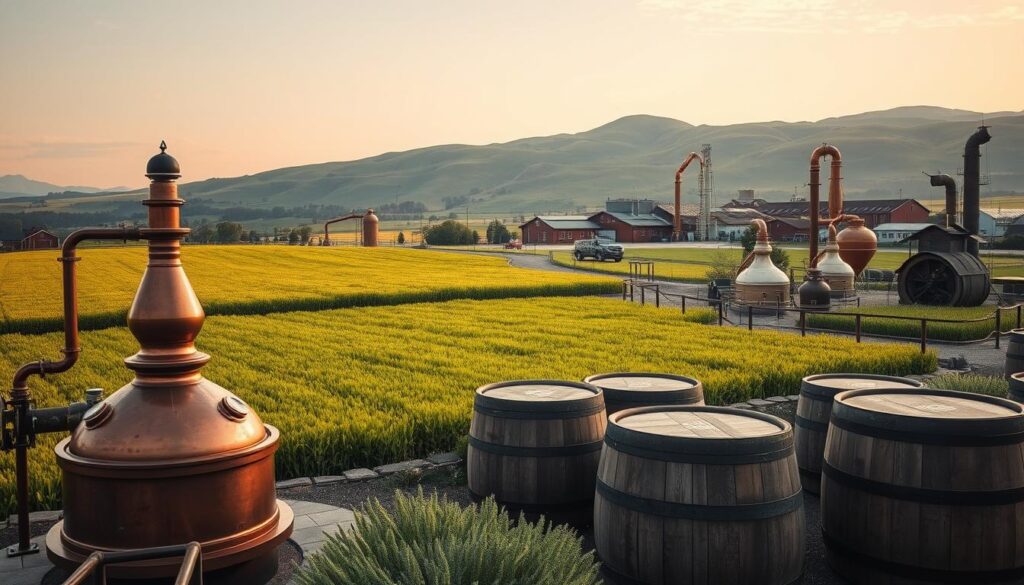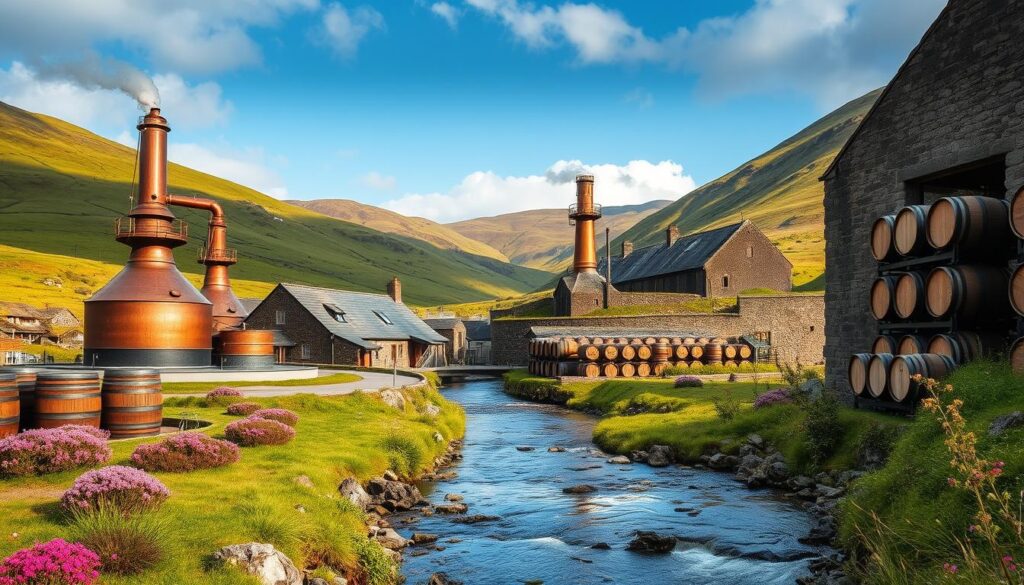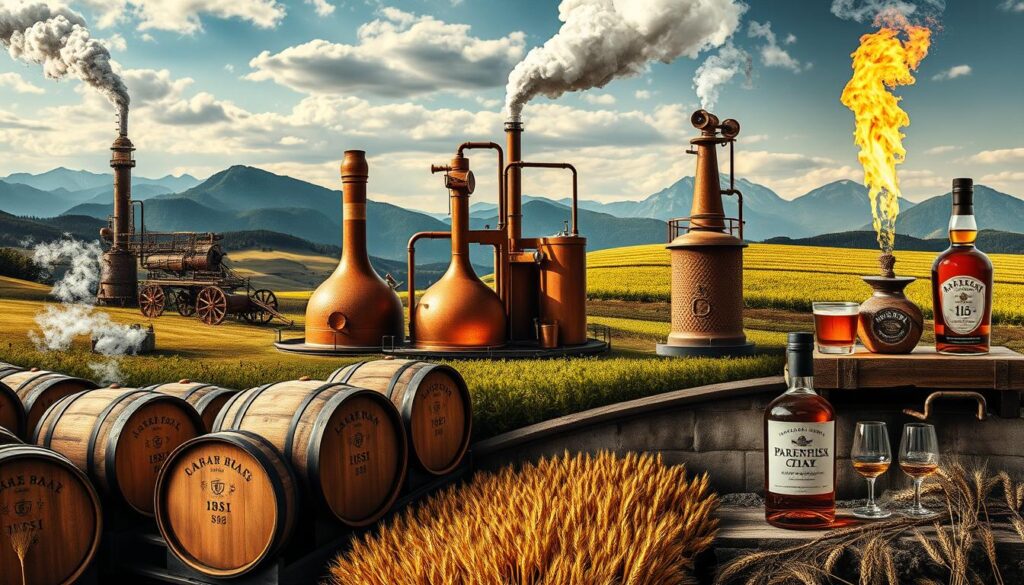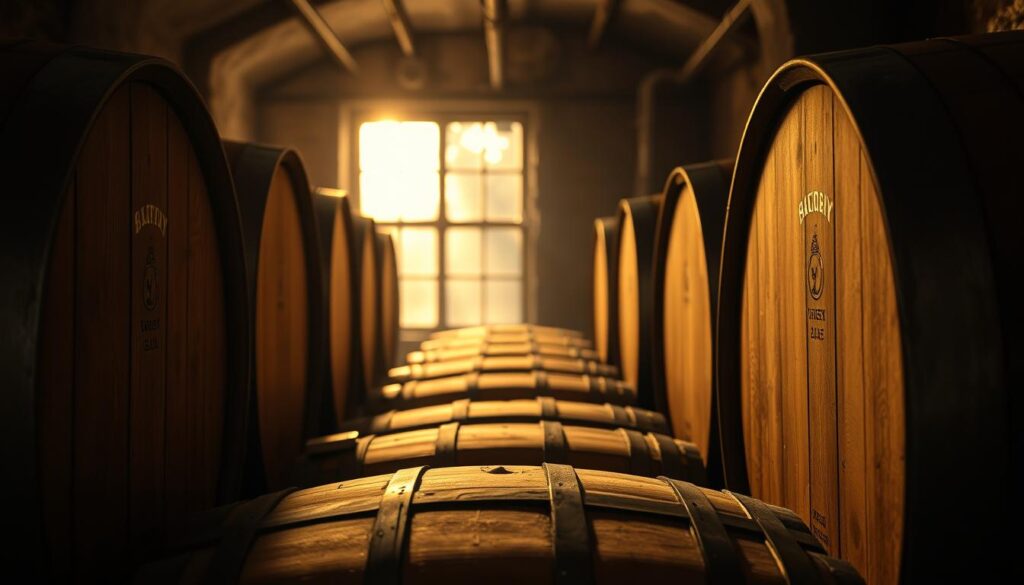The world of spirits shows interesting differences between whiskey and whisky. These terms refer to the same distilled alcoholic beverage made from fermented grain mash. However, their spelling varies depending on the region of production. In Ireland and America, they say ‘whiskey.’ But in Scotland, Canada, and Australia, it’s ‘whisky.’
Both spirits age over time and feature a range of flavors and styles. However, ingredients, production methods, and regional traditions subtly shape the final product. The distinction often sparks debate among enthusiasts and collectors, with each version boasting a unique heritage and following.
Though the difference may appear minor, it holds profound significance for connoisseurs and producers alike. Dive in to explore the origins and nuances that define these iconic spirits.
Understanding the Origins of Whisk(e)y
The story of whiskey begins in ancient Celtic lands. The word comes from Gaelic uisce, which means “water of life.” This name comes from the sacred practice of distillation in medieval monasteries.
Irish monks first wrote about these distillation methods in the 9th century. This is when whiskey was born.
Scotland and Ireland both claim to be the birthplaces of whiskey. Irish monks first recorded whiskey production while teaching Scottish monks, spreading the art of distillation across Celtic regions.
Each area developed its own unique whiskey. The Scottish version lost the ‘e’ from whiskey, creating a difference that lasts to this day.
The journey of whiskey from monasteries to the world shows centuries of improvement. Modern American whiskey production keeps ancient Celtic techniques but also brings new ideas. Copper pot stills, key in making early whiskey, remain in use today.
This mix of old and new defines whiskey-making worldwide.
Each region has its own take on these old methods. Irish whiskey undergoes triple distillation, while Scotch uses double distillation. These differences make each whiskey unique.
Regional Variations in Production Methods
Whiskey making varies widely across places, making each spirit unique. In Ireland, most distillers use triple distillation, which makes their whiskey very smooth. This is different from Scotland, where 60% of whisky is double distilled.
Every region has its own way of making whiskey. Irish whiskey often mixes malted and unmalted barley, with other grains making up half. In Scotland, 80% of whisky production uses malted barley. The Isle of Islay adds peat to 30% of their malting, giving their whiskey a smoky flavor.
The aging process is also key in whiskey making. Both Irish and Scottish spirits need at least three years in oak barrels. Scottish producers use different casks, like ex-bourbon and sherry, for 70% of their whisky. This leads to Irish whiskey’s lighter, fruitier taste in 80% of cases. Scottish whiskies, on the other hand, have a wider range of flavors.

1. American Whiskey
American spirits have a deep history in the world of distilled drinks. The United States is famous for its strict traditions in making bourbon and rye whiskey, which set high production standards.
Bourbon whiskey is America’s native spirit. It must contain at least 51% corn. Bourbon whiskey ages in new, charred oak barrels, giving it a sweet, vanilla taste. Kentucky’s water is perfect for bourbon because of its limestone, but any U.S. state can make bourbon.
Rye whiskey is another key part of American distilling. It must have at least 51% rye grain, making it spicier than bourbon. During Prohibition, many distilleries closed, but they came back stronger. They kept traditional methods but also added new ones.
The American spirits industry has high-quality standards. Both bourbon and rye must distill at less than 160 proof and age in new, charred oak barrels. The different climates in different regions add to the unique flavors of each American whiskey.
2. Bourbon and Tennessee Whiskey
Tennessee whiskey is special because of the Lincoln County Process. This method filters the spirit through sugar maple charcoal, making it smoother.
Bourbon making has strict rules in the U.S. The mash bill must contain at least 51% corn, but many distilleries use up to 70%. Both spirits age in American oak barrels, used only once for the best flavor.
Kentucky is the top state for bourbon, with almost 100 distilleries. Tennessee has about 30 distilleries for its whiskey. Each, like Jack Daniel’s and Uncle Nearest, has its own way of making Tennessee whiskey. Uncle Nearest uses 12 to 16 feet of charcoal for a unique smoothness.
Both spirits show off American distilling skills but stay true to themselves. Bourbon can be made anywhere in the U.S., but Tennessee whiskey must be made in Tennessee. This rule, along with the charcoal mellowing, makes Tennessee whiskey special.

3. Scotch Whisky
Scotland’s whisky history goes back to 1494, with the first mention of Scotch whisky in records. Making Highland whisky was tough, with the crown taking 1,000 stills in 1782 over taxes.
Scotch whisky making follows strict Scottish laws. Each bottle must age for at least three years in oak casks under 700 liters, all in Scotland. Scotland’s cool, damp weather adds unique flavors to every sip.
Scotland’s different whisky areas create unique tastes. The Highlands have rich, full-bodied scotch, while Islay produces smoky, peated varieties. Speyside makes lighter, fruitier scotches. With over 130 active distilleries, Scotland leads the whisky world.
Unlike American whiskey, Scotch whisky makers use only natural enzymes in fermentation. This traditional method, along with Scotland’s pure water, makes scotch a favorite globally. India is the top buyer of scotch.
4. Japanese Whisky
Japanese whisky emerged in 1929 with the founding of Suntory’s Yamazaki Distillery, and it quickly gained international acclaim for its refined, elegant style. Japanese whisky draws heavy influence from Scottish methods, from distillation to aging, but Japanese distillers focus intensely on precision and craftsmanship.
One of the hallmarks of Japanese whisky is its attention to detail, with a focus on selecting the finest ingredients. It also emphasizes creating balanced blends that appeal to a global audience.
The quality of Japanese whisky is partly due to the country’s climate and water, which contributes to smoother, more delicate flavors. The cool, temperate climate allows for slower maturation, giving the whisky time to develop complexity. Brands like Yamazaki, Hakushu, and Nikka have gained international recognition for their premium offerings.Japanese whisky is famous for being softer and more refined compared to Scotch, with flavors ranging from delicate floral notes to rich fruitiness.
Japanese distillers also experiment with different cask types, including Mizunara oak, which imparts unique flavors not typically found in Scotch whisky. As a result, Japanese whisky has gained a reputation for quality, winning numerous awards and earning a devoted following worldwide.
5. Indian Whisky
Indian whisky has become increasingly popular in recent years. Amrut Distilleries led the charge by releasing India’s first single malt in 2004. The country’s warm climate accelerates the aging process, allowing Indian whisky to mature faster. This helps develop bold, complex flavors in a relatively short amount of time. This rapid maturation often results in whisky that is rich, spicy, and full of character.
The warmth of the Indian climate contrasts with the slower aging in cooler climates. This gives Indian whisky a distinct edge in terms of flavor intensity. The whisky is often rich with bold fruit notes, spice, and a slightly smoky finish. The growing demand for Indian whisky has made it a significant player in the global whisky market.
Notable Indian whisky brands include Amrut, Paul John, and Rampur, each offering unique expressions that highlight India’s distinct approach to whisky-making.
6. Canadian Whisky
Canadian whisky often stands out for its smoothness and versatility. While Canadian whisky primarily uses corn, it typically includes a blend of grains. Rye is often part of this blend, giving the whisky a distinctive spicy kick.
Canadian whisky has earned a reputation for its easy drinkability and smoother profile compared to other types of whisky. In fact, many Canadian whiskies use the label “rye,” even though they may not contain a majority of rye grain.
Canadian whisky production follows strict regulations. It must age in Canada for at least three years in oak barrels. However, distillers often age it much longer to develop its characteristic smoothness.
Canadian whisky earns renown for its blending tradition, with distillers combining various grains to create a balanced and harmonious spirit. Canada is also popular for producing a variety of different whisky types, from light and mild to bold and spicier rye-based whiskies.
Brands like Crown Royal, Canadian Club, and Forty Creek are popular internationally, with Crown Royal being one of the best-selling whiskies in the world.

The Impact of Aging and Barrels
The maturation process is key in whiskey making, with 80% of its flavor coming from oak barrels. This journey turns raw spirits into complex drinks through wood interaction.
Oak barrels shape whiskey’s character. American white oak, or Quercus Alba, is the main choice. These barrels add flavors like vanilla, toast, butterscotch, and honey. The charring of barrels adds deep colors and rich tastes during aging.
Different places have their own aging rules. Scotch needs at least three years, while Pendleton Whisky ages for three years in small oak barrels. Climate affects aging – warmer places speed it up, while cooler ones like Japan slow it down.
The magic of aging happens as barrels breathe and spirits oxidize. Temperature changes make the liquid move in and out of the wood, getting flavors. Bourbon requires new charred oak barrels, which give it its unique taste. This process brings out flavors of brown sugar, creamy crème brulée, and warming spices.

Modern Trends in Whisk(e)y Production
The craft spirits movement has changed whiskey making worldwide. New distilling methods are making old ways seem old-fashioned. Craft distillers are at the forefront, trying new aging and flavors. Emerging regions & trends in the world of whiskey are now shaping the future of the spirit, as distillers push the boundaries of aging processes and flavor combinations.
In the U.S., craft whiskey grew by 28.1% to 26 million cases by late 2017. Bourbon is the biggest player, making up 46.4% of the market.
Premium spirits are leading the market’s growth. Value spirits’ share fell from 40% to 30% of sales. Maker’s Mark grew by 25% in the UK, and Irish whiskey saw a 4.3% increase.
Young people are into whiskey because of creative cocktails, which are growing by 10% a year. Brands like Douglas Laing, Auchentoshan, and Haig Club are attracting new fans with cool packaging and marketing. This shows a trend towards better quality and unique tastes.
The world of whiskey is always changing. Irish distilleries grew from 2 in the 1980s to 18 by 2017. The Irish Whiskey Association aimed for 10 million cases by early 2018, showing the market’s energy. These changes show the industry’s mix of tradition and new ideas in making spirits.
Whiskey vs Whisky: Embrace the Heritage and Start Your Journey
The distinction between “whiskey” and “whisky” is more than a simple matter of spelling. It represents a deep connection to cultural traditions and regional identities.
The Irish and American spelling, of “whiskey,” and the Scottish and Canadian “whisky” each embody the craftsmanship and heritage unique to their origins.
Every bottle tells a story of geography, history, and the artistry that goes into its creation. Each sip becomes a journey into its rich cultural backdrop.
Now that you know the difference between whiskey and whisky. Explore more about Scotland’s legendary whisky heritage. Discover the best Scottish whiskies and their unique stories at Scotland Whisky — your journey into the world of whisky starts here!